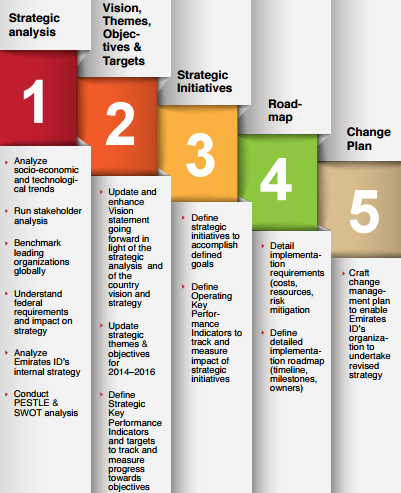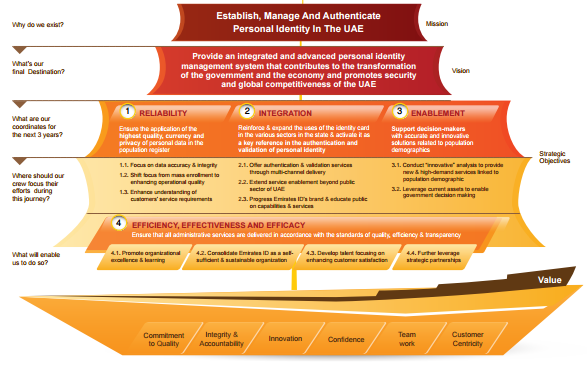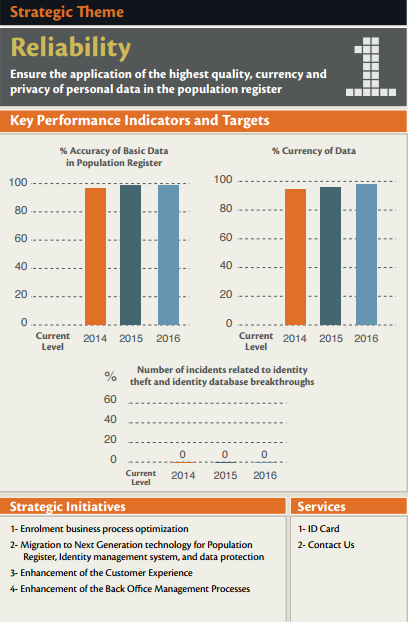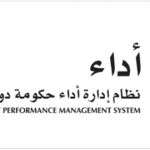Strategy Formulation: Emirates Identity Authority Strategic Plan 2014-2016

The Emirates Identity Authority (EIDA) is an independent federal authority in the UAE that was established in 2004. EIDA’s main purpose as a governmental agency is focused on “the establishment of a modern population register in order to facilitate the obtainment of government services as well as to provide the required information for supporting decision making, strategic planning and the allocation of sources in all vital sectors in the UAE”, as documented on their website.
Back in 2010, when the Population Register and ID Card System were their priorities in terms of strategic agenda, The Emirates Identity Authority was one of the first public institutions in the UAE that have developed and implemented a strategy and performance management system based on the Balanced Scorecard methodology and directives from the UAE Prime Minister’s office (PMO).
Since 2010, EIDA has already successfully developed and executed their 2010-2013 strategy and, in order to keep in line with governmental wide strategic directions, they set forward in developing their 2014-216 Strategic Plan.
This undertaking has been based on an approach containing five phases:
- Strategic Analysis;
- Vision, Themes, Objectives & Targets;
- Strategic Initiatives;
- Roadmap;
- Change Plan.
The main activities within each of the five phases can be observed in the accompanying extract from the Strategic Plan.

In order to maximize the relevance of the strategic planning process, EIDA’s strategic analysis phase was based on reviewing five main sources of information:
- Reviewing the Prime Minister’s Office 2014-2016 strategic guidance and 2021 Vision;
- External and industry environmental scan;
- Benchmarking against global ID management leaders;
- Assessment of Emirates ID’s existing strategy;
- PESTLE and SWOT summarizing findings from all sources.
Results from the Strategy Analysis were used as key inputs in formulating Emirates ID’s strategy for the upcoming three years. In correlation with the mandate EIDA was given by the UAE’s federal government, the management team identified 10 key areas to address through the 2014-2016 strategy. These were arranged in four Strategic Themes which are considered to stand at the basis of the Strategic Plan. The four themes are detailed below, as described in the 2014-2016 Strategic Plan:
- RELIABILITY (Identity Lifecycle & Data Management) – Ensure the application of the highest quality, currency and privacy of personal data in the population register;
- INTEGRATION (Primary Identity Authenticator) – Reinforce and expand the uses of the identity card in the various sectors in the state and activate it as a key reference in the authentication and validation of personal identity;
- ENABLEMENT (Supporting Decision Making) – Support decision-makers with accurate information and innovative solutions related to population demographics;
- EFFICIENCY, EFFECTIVENESS AND EFFICACY (Organizational Excellence) – Ensure that all administrative services are delivered in accordance with the standards of quality, efficiency and transparency.
Their Vision statement, another key aspect in formulating EIDA’s strategy, was also reviewed and redesigned. The question that they made sure their updated Vision answered was “What’s our final destination?”
By answering this question and considering alignment with the federal mandate, the Emirates Identity Authority finalized their Vision statement that reads as follows: “Provide an integrated and advanced identity management system that contributes to the transformation of the government and the economy and promotes security and global competitiveness of the UAE.”
In their journey towards articulating the Strategic Plan, one key aspect was developing clear strategic objectives that translate their vision and mission into concise items and provide the main focus of the organizations for the upcoming period.
Clustering the objectives on the four Strategic Themes was the last step in the process of structuring a crucial strategic tool: The Emirates ID Strategy Map.

The final step in the process was to ensure that the achievement of each of the objectives included in the Strategy Map can be monitored, measured and facilitated. To this end, the Emirates ID team selected Key Performance Indicators (KPIs) that would measure achievement against established targets and established Strategic Initiatives that would serve as the catalyst for bridging the gap between current and desired performance levels.
The example on the left focuses on the “Ensure the application of the highest quality, currency and privacy of personal data in the popular register” Strategic Objective.
As we can see, Emirates ID has selected three KPIs in order to measure its achievement:
- % Accuracy of basic data in population register;
- % Currency of data;
- % Number of incidents related to identity theft and identity database breakthroughs.
Furthermore, the accomplishment of the objective is supported by a set of four Strategic Initiatives:
- Enrollment business process optimization;
- Migration to Next Generation technology for Population Register, Identity management system, and data protection;
- Enhancement of the Customer Experience;
- Enhancement of the Back Office Management Processes.

The same approach was followed for all of the objectives included in the 2014-2016 Strategy Map, resulting in a clear and documented Scorecard for the organization.
Emirates Identity Authority’s strategic planning process represents a good practice approach in formulating and structuring the strategy of a governmental agency. This case study shows the positive direction that public institutions in the UAE are moving towards in adopting a clear strategic and performance management system that will allow them to actively monitor and improve performance and, at the same time, provide a transparent and reliable reporting framework that the public can access.
Image sources:

Tags: Government performance, Organizational Strategy, Performance in UAE, Successful Strategy Execution





